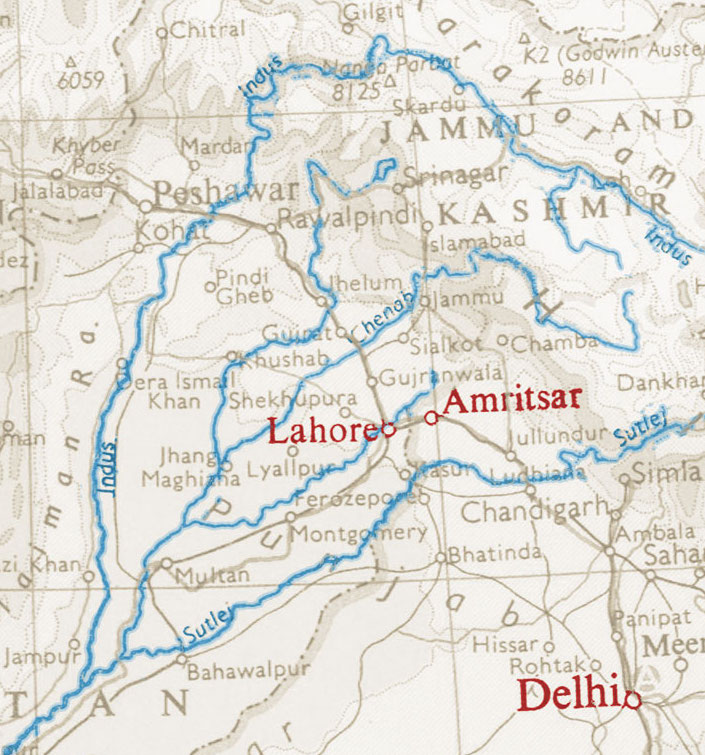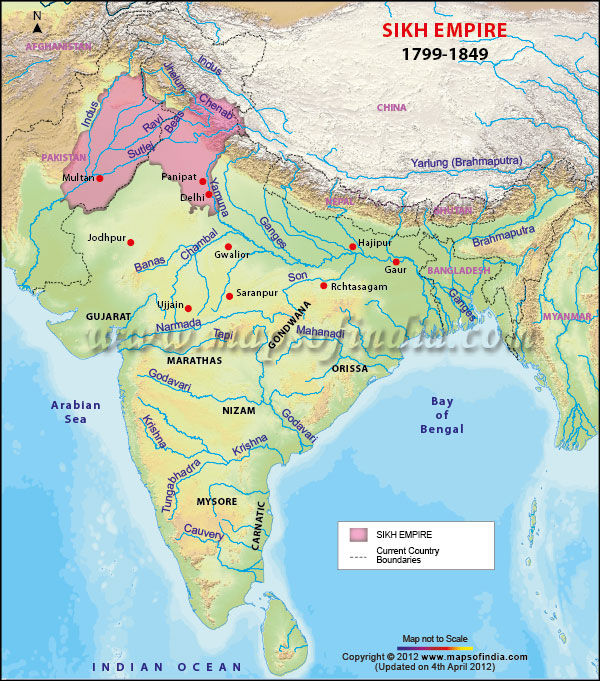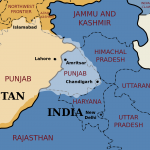
North India featuring the five rivers of the Punjab. The Beas, Ravi, Sutlej, Chenab and Jhelum Rivers descend from the Himalayas and merge with the Indus River on their way to the Arabian Sea. Source: “Indo-Arabia, Plate 27, Vol II” in The Times Atlas of the World, Mid-Century Edition. London: John Bartholomew & Son, Ltd, 1959, David Rumsey Map Collection.
The Punjab region is located in the northern part of the Indian subcontinent and is presently divided into the modern countries of India and Pakistan. The Punjab (also spelled Panjab) means “the land of five rivers” (Panj = five + ab=water) representing the Beas, Ravi, Sutlej, Chenab, and Jhelum rivers. All of the rivers descend from the Himalayas into the rich agricultural land of the Punjab where they join the Indus River. The region has one of the longest and richest histories in the world. It lay in the heart of the Indus Valley Civilization (c 3300-1300 BCE), one of the world’s earliest and most sophisticated civilizations. The region’s location and rich natural resources brought many soldiers, traders, and travelers from across the Himalayas towards central Asia, such as the Greeks (under Alexander the Great), the Huns, Scythians, Mongols, Turks, Arabs, Parsis, Mughals, and the British. The region is diverse in terms of religions, cultures, and languages. The Punjab is the birthplace of the most recent major world religion, Sikhism, but it is also home to millions of Muslims and Hindus.
Punjabi Culture
The term “Punjabi” refers to the spoken language, literature, food, cultural traditions, art, values, and history of the Punjabi people. Punjabi can mean both a speaker of the Punjabi language and a person who lives or whose family originates in the Punjab. The distinctive music, folk dances, fashion, and art from the Punjab enjoy a disproportionate cultural influence in the Indian subcontinent. In Bollywood cinema, for instance, Punjabi actors, music, and dances predominate. The Bhangra, the popular Punjabi folk dance, has an enormous cultural influence in India and throughout the diaspora where it has merged with the hip hop musical form in major urban areas.
Punjabi language
The Punjabi language is an Indo-European language that originates in the Punjab region. Punjabi is spoken by 130 million native speakers, making the language the tenth most spoken language in the world. Reflecting the diverse peoples and cultural influences in this part of the world, the Punjabi language is written in multiple scripts: Shahmukhi (پنجابی ) which is a Perso-Arabic script, and the distinctive Gurmukhi (ਪੰਜਾਬੀ ) script. Gurmukhi is the sacred script in the Sikh religion, meaning “from the mouth of the Guru.” Gurmukhi was standardized by the second Sikh Guru, Guru Angad Devi Ji, in the sixteenth century so that Guru Nanak’s divine message would not become misinterpreted over time. Punjabi is also written in the Devanagari script, the same script as Hindi. Like other major north Indian languages, Punjabi is derived from Sanskrit, but it also borrows words from Arabic, Persian, Turkish, English, and other languages. Punjabi is the dominant language in much of Pakistan where it is written in the Shahmukhi script. In the Indian Punjab, the Gurmukhi script is the standard written form of Punjabi.
Punjabi is also widely spoken wherever Punjabis have settled all over the world. It is the third most widely spoken language in Canada, and the fourth in England. In California the majority of Punjabi speakers are Sikh, but there are also Punjabi speakers who are Muslim and Hindu. The Punjabi Sikh community has worked hard to maintain the Punjabi language because of its close relationship with the Sikh scripture and identity. Punjabi is the liturgical language in Sikhism. As the number of Sikh families grew in California beginning in the 1970s and 1980s, the need to teach the Punjabi language to preserve their cultural and religious identity also grew. Punjabi is taught in Sunday khalsa schools that are primarily located in Gurdwaras (Sikh temples). Many of the leading universities in the state offer courses in Punjabi, including the University of California campuses at Berkeley, Santa Cruz, Santa Barbara and Irvine, and at Sacramento State University. Punjabi is also taught in certain public schools with substantial Punjabi American student enrollments, such as in the Yuba City Unified School District.
Religions
The major religions in the Indian Punjab are Sikhism, Hinduism, and Islam. Sikhism was founded by Guru Nanak in the fifteenth century and important holy sites are located in the Punjab region in the present-day countries of India and Pakistan. Guru Nanak transformed the religious landscape of northern India. Nanak’s teachings provided a watershed moment in Indian religious traditions, and he is revered not just by the Sikhs but by other religious communities as well. It is important to note that prior to the 1947 partition Muslims formed the majority religious community in the Punjab. After partition, Sikhism is the dominant faith in the Indian Punjab, but the state is still religiously diverse. The current demographics of the religious communities in the state are as follows: approximately 58% of the population are Sikhs and 38% are Hindus with relatively small numbers of Muslims, Jains, Buddhists, and Christians.
BRIEF MODERN HISTORY OF THE PUNJAB
Mughal Empire
The birth of the Sikh religion roughly coincided with the rise of the Mughal Empire in the Indian subcontinent in the 1500s. In the early years, the relationship between the Sikhs and the Mughal Islamic Empire was relatively peaceful. The Mughal ruler, Akbar, cultivated cordial relationships with the Sikh community, but the relationship between the Mughal ruling families deteriorated after his death. Akbar’s son, Mughal ruler Jahangir, persecuted the Sikh community and ordered the torture and execution of Guru Arjan (the fifth Sikh Guru) in 1606. The Mughal ruler, Aurangzeb, used religion as a tool to dominate the Sikh and Hindu communities and sow dissension between them. When the Sikh Guru Tegh Bahadur was arrested by Aurangzeb, he was given the choice to either convert to Islam or death; he chose adherence to his faith and was executed in 1675. Guru Tegh Bahadur is highly revered in India for his courage in sacrificing his life in defense of religious freedom. It was in the midst of the persecution and warfare with the Mughal rulers that the tenth Guru Gobind Singh united diverse communities into one caste-less, egalitarian brotherhood (khalsa) on March 30, 1699. The martial tradition within the Sikh community developed in response to the repression and armed conflict with the Mughal rulers.
Sikh Empire

With the decline of the Mughal Empire, the Sikhs grew more powerful in northern India in the eighteenth century. Maharaja Ranjit Singh created a secular state with a powerful army that lasted from 1799 to 1849 in the greater Punjab region. The Sikhs are proud that they were among the last communities in India to be annexed by the British. During the 1840s, the Punjabis, who were fierce warriors, waged three of the bloodiest battles in South Asian history against the British in Mudki, Sobraon, and Chillianwala.
British Annexation of 1849
Shortly after the death of Maharaja Ranjit Singh, British interventions and internal divisions weakened the Sikh state. As a result, the British were able to successfully annex their territory and soon established the Punjab as a province within the British Empire. Impressed by the martial prowess of the Sikhs, the British considered them a so-called “martial race” and rewarded them with preferential employment in the colonial army and police force.
Context for the Global Punjabi Diaspora in the Late Nineteenth Century
In the late nineteenth century, the conditions developed that led many Punjabis to leave India to join the British Army and colonial police force throughout the empire. The Sikh farmers faced increased taxation, debt, and population and land pressures. Especially in the Doabi area in the Punjab, the land pressures were quite acute, and many sons in farming families were unable to inherit enough land to secure a livelihood for their own families. Without other attractive sources of employment in the Punjab, many young men secured employment in the British Army and police force and travelled across the world to protect the empire. Unlike caste Hindus, Sikhs did not have any religious taboos against traveling abroad.
India’s Freedom Movement and Independence in 1947
The Punjabis played an early and active role in India’s freedom movement both in India and in the diaspora. Punjabi pioneers on the West Coast of North America waged the Gadar (“revolutionary”) movement to overthrow the British colonial government. Kartar Singh Sarabha, a Sikh revolutionary in the Gadar movement, was executed in 1915. Another inspirational Sikh freedom fighter was the young revolutionary, Bhagat Singh. The massacre of Sikhs, Hindus and Muslims by British forces in the Jallianwala Bagh in Amritsar, Punjab on April 13, 1919 played a decisive role in galvanizing widespread popular support for India’s Independence throughout the country. There was a wide-scale participation in the Punjab in the anti-colonial freedom movement up until India’s independence on August 15, 1947.
Partitions of the Punjab in 1947 and 1966

Map detailing the partition of Punjab
As part of the arrangements to transfer power from the British colonial government to Indian politicians, the regions of Punjab and Bengal were divided in two. Contiguous territories with Muslim majority populations in western Punjab and in eastern Bengal were given to Pakistan, and the Hindu and Sikh majority territories remained in India. In the largest human migration in history, an estimated 14 million people crossed the new borders between Pakistan and India with many Muslims relocating to Pakistan and Sikhs and Hindus relocating to India. Two decades later, the Indian Punjab was further divided, this time along linguistic lines into three states (Punjab, Haryana, and Himachal Pradesh) according to the Punjab Reorganization Act of 1966.
Contemporary Punjab
The 1980s was a turbulent decade for Sikhs in India. The history of the relationship between the Sikh community and the Indian government from the 1970s until the 1990s is still highly contested. The wounds have not yet healed.
Many Sikh accounts emphasize that the relationship with the Indian government grew more contentious long before 1984 when their long-standing peaceful demands for greater political autonomy, and water and territorial rights, were not granted. Although the broad-based political movement in the Punjab was generally peaceful, growing frustration among some Sikhs led them to join an armed insurgency. Amidst these growing tensions, in June of 1984 the Indian army under Prime Minister Indira Gandhi stormed the Golden Temple in Amritsar, Punjab (the holiest Sikh temple). During this attack, the Indian army killed thousands of innocent devotees along with the militants; the holiest Sikh temple was also severely damaged. On October 31, 1984, Prime Minister Indira Gandhi was assassinated by her two Sikh bodyguards to avenge the deaths of the Sikh men, women and children who were killed in the Golden Temple attack. In the days after Indira Gandhi’s assassination, Sikh accounts and international human rights organizations estimate that as many as 30,000 Sikhs were killed in a wave of violence in Delhi and other cities across India. Many Sikhs left India for the United States and other countries due to the political situation in India where they felt unsafe and unable to exercise their freedom of speech.
The Indian government, and the scholars who base their histories on official sources, tell a very different history. In this version of events, the Indian government led a military operation against militants in the Golden Temple in order to quell an armed rebellion. The attack on the Sikh temple was justified by the growing separatist movement to establish a Sikh homeland. The government estimates that approximately 3,000 Sikhs were killed in Delhi alone in retribution for the Prime Minister’s assassination. Government accounts emphasize that the relationship with the Sikh community has improved recently. For instance, in 2004, Dr. Manmohan Singh was the first Sikh to serve as the Prime Minister of India, and he was re-elected for a second term in the Congress Party.
Punjab is one of the most prosperous states in India. It is called India’s bread basket due to its high agricultural productivity and the region was one of the success stories of the Green Revolution. Farmers in the Punjab were among the first in the nation to adopt Green Revolution technology during the 1960s and 1970s. According to Ahloowalia, et al, “wheat production in the state increased from 1.7 million tons in 1950 to 14.6 million tons in 2010. Rice production increased from 0.11 million tons in 1950 to 10.26 million tons in 2010.” The principal crops grown in the Punjab are wheat, sugar cane, fruits, and vegetables. The state produces 2% of the world’s cotton, 2% of its wheat, and 1% of its rice. The Punjab has fertile alluvial soil, excellent water resources from the Himalayas, a year-round growing season, and industrious farmers. Recently, the region’s agriculture has been in decline, however, due to the decreasing productivity of its soil and the overuse of pesticides. Many farmers in the Punjab today are facing incredible hardships. The state enjoys a modern infrastructure, and it receives one of the highest levels of remittances from abroad in India (only the Indian states of Kerala, Tamil Nadu and Uttar Pradesh rank higher).
SOURCES:
Ahloowalia, B.S., et al, Punjab Agriculture: The Challenges Ahead (Ludhiana, Punjab: Aesthetics Publications, 2015).
Amnesty International, https://www.amnesty.org.in/show/news/thousands-call-for-justice-for-victims-of-1984-sikh-massacres
Banga, Indu. Five Punjabi Centuries: Policy, Economy, Society and Culture, c. 1500-1900. Essays for J. S. Grewal (New Delhi, Manohar, 1997).
Banga, Indu and J.S. Grewal, Eds., Maharaja Ranjit Singh and His Times (Amritsar, India: Guru Nanak Dev University, 1980).
Bhatia, Sardar Singh, and Anand Spencer, Eds., The Sikh Tradition: A Continuing Reality: Essays in History and Religion (Patiala, India: Punjabi University, 1999).
Khan, Yasmin. The Great Partition: The Making of India and Pakistan (Yale: New Haven, 2007).
McLeod, W.H., The Sikhs: History, Religion, and Society (New York: Columbia, 1989).
Mitta, Manoj and HS Phoolka, When A Tree Shook Delhi: The 1984 Carnage and its Aftermath (New Delhi: Roli Books, 2007).
Mukhopadhyay, Nilanjan. Sikhs: The Untold Agony of 1984 (New Delhi: Westland, 2015).
